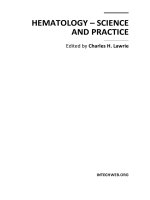ln hematology mlt final
Bạn đang xem bản rút gọn của tài liệu. Xem và tải ngay bản đầy đủ của tài liệu tại đây (8.35 MB, 0 trang )
LECTURE NOTES
For Medical Laboratory Students
Hematology
Yared Alemu, Alemayehu Atomsa,
Zewdneh Sahlemariam
Jimma University
In collaboration with the Ethiopia Public Health Training Initiative, The Carter Center, the
Ethiopia Ministry of Health, and the Ethiopia Ministry of Education
2006
Funded under USAID Cooperative Agreement No. 663-A-00-00-0358-00.
Produced in collaboration with the Ethiopia Public Health Training Initiative, The Carter
Center, the Ethiopia Ministry of Health, and the Ethiopia Ministry of Education.
Important Guidelines for Printing and Photocopying
Limited permission is granted free of charge to print or photocopy all pages of this
publication for educational, not-for-profit use by health care workers, students or faculty.
All copies must retain all author credits and copyright notices included in the original
document. Under no circumstances is it permissible to sell or distribute on a commercial
basis, or to claim authorship of, copies of material reproduced from this publication.
©2006 by Yared Alemu, Alemayehu Atomsa, Zewdneh Sahlemariam
All rights reserved. Except as expressly provided above, no part of this publication may
be reproduced or transmitted in any form or by any means, electronic or mechanical,
including photocopying, recording, or by any information storage and retrieval system,
without written permission of the author or authors.
This material is intended for educational use only by practicing health care workers or
students and faculty in a health care field.
PREFACE
The lack of sufficient reference materials and uniformity
in course syllabi has always been a problem in higher
institutions in Ethiopia that are engaged in training
health professionals including laboratory technologists.
Hence, the authors hope that this lecture note would be
immensely useful in solving this existing problem at
significant level. The lecture note is intended for use by
laboratory technologist both during their training and in
their work places. There are twenty two chapters each
beginning with specific learning objectives in which
succeeding by a background of the topic in discussion.
There are study questions at the end of each chapter for
the reader to evaluate his understanding of the contents.
In addition, important terms are defined in the glossary
section at the end of the text.
ACKNOWLEDGEMENT
It is with sincere gratitude and pleasure that we
acknowledge The Carter Center for the collaboration in
preparation of this lecture note.
Special thanks are due to Mohammed Awole, Serkadis
Debalke, Ibrahim Ali, Misganaw B/sellasie, Abiye
Shume, Shewalem Shifa and Simon G/tsadik for their
assistance in reviewing and critiquing this material.
For her sustained devotion and extra effort, I express my
deep gratitude and sincere appreciation to Zenaye
Hailemariam, who has been most supportive with
scrupulous attention and dedication in helping me
throughout the preparation of this lecture note (Y.A).
Table of Contents
Preface .....................................................................i
Acknowledgement ....................................................ii
Table of Contents ......................................................iii
Introduction ...............................................................v
1. Blood.....................................................................1
2. Blood Collection ....................................................42
3. Anticoagulants ......................................................61
4. Preparation of Blood Smears ...............................67
5. Staining of Blood Smears .....................................77
6. Hemocytometry ....................................................89
7. Differential Leucocyte Count.................................122
8. Reticulocyte Count................................................136
9. Hemoglobin...........................................................146
10. Packed Cell Volume ...........................................176
11. Red Cell Indices ..................................................188
12. Erythrocyte Sedimentation Rate .........................197
13. Osmotic Fragility of the Red Cell ........................209
14. Bone marrow smear examination .......................215
15. Lupus Erythematosus Cell ..................................226
16. Red cell Morphology Study .................................232
17. Anemia ................................................................244
18. Hematological Malignancies ...............................311
19. Leucocyte cytochemistry ....................................339
20. Hemostasis .........................................................357
21. Body fluid analysis ..............................................434
22. Automation in Hematology ..................................466
Glossary ...................................................................477
References ...............................................................567
INTRODUCTION
The word hematology comes from the Greek haima
(means blood) and logos (means discourse); therefore,
the study of hematology is the science, or study, of
blood.
Hematology encompasses the study of blood
cells and coagulation.
Included in its concerns are
analyses of the concentration, structure, and function of
cells in blood; their precursors in the bone marrow;
chemical constituents of plasma or serum intimately
linked with blood cell structure and function; and function
of platelets and proteins involved in blood coagulation.
The study of blood has a very long history.
Mankind
probably has always been interested in the blood, since
primitive man realized that loss of blood, if sufficiently
great, was associated with death.
And in Biblical
references, “to shed blood” was a term used in the
sense of “to kill”.
Before the days of microscopy only the gross
appearance of the blood could be studied.
Clotted
blood, when viewed in a glass vessel, was seen to form
distinct layers and these layers were perceived to
constitute the substance of the human body. Health and
disease were thought to be the result of proper mixture
or imbalance respectively of these layers.
Microscopic examination of the blood by Leeuwenhoek
and others in the seventeenth century and subsequent
improvements in their rudimentary apparatus provided
the means whereby theory and dogma would gradually
be replaced by scientific understanding.
Currently, with the advancement of technology in the
field, there are automated and molecular biological
techniques enable electronic manipulation of cells and
detection of genetic mutations underlying the altered
structure and function of cells and proteins that result in
hematologic disease.
Hematology
CHAPTER ONE
BLOOD
Learning Objectives
At the end of this chapter, the student shall be able to:
•
Explain the composition of blood
•
Describe the function of blood
•
Describe the formation of blood cells.
•
Explain the regulatory mechanisms in hemopoiesis
•
Indicate the sites of hemopoiesis in infancy,
childhood and adulthood
.1 Composition blood
1
Hematology
Blood is a circulating tissue composed of fluid plasma
and cells.
It is composed of different kinds of cells
(occasionally called corpuscles); these formed elements
of the blood constitute about 45% of whole blood. The
other 55% is blood plasma, a fluid that is the blood's
liquid medium, appearing yellow in color. The normal pH
of human arterial blood is approximately 7.40 (normal
range is 7.35-7.45), a weak alkaline solution. Blood is
about 7% of the human body weight, so the average
adult has a blood volume of about 5 liters, of which 2.7-3
liters is plasma. The combined surface area of all the
red cells in the human body would be roughly 2000
times as great as the body's exterior surface.
Blood plasma
When the formed elements are removed from blood, a
straw-colored liquid called plasma is left.
Plasma is
about 91.5% water and 8.5% solutes, most of which by
weight (7%) are proteins.. Some of the proteins in
plasma are also found elsewhere in the body, but those
confined to blood are called plasma proteins.
These
proteins play a role in maintaining proper blood osmotic
pressure, which is important in total body fluid balance.
Most plasma proteins are synthesized by the liver,
2
Hematology
including the albumins (54% of plasma proteins),
globulins (38%), and fibrinogen (7%). Other solutes in
plasma include waste products, such as urea, uric acid,
creatinine, ammonia, and bilirubin; nutrients; vitamins;
regulatory substances such as enzymes and hormones;
gasses; and electrolytes.
Formed elements
The formed elements of the blood are broadly classified
as red blood cells (erythrocytes), white blood cells
(leucocytes) and platelets (thrombocytes) and their
numbers remain remarkably constant for each individual
in health.
I. Red Blood Cells
They are the most numerous cells in the blood.
In
adults, they are formed in the in the marrow of the bones
that form the axial skeleton. Mature red cells are nonnucleated and are shaped like flattened, bilaterally
indented spheres, a shape often referred to as
”biconcave disc” with a diameter 7.0-8.0µm and
thickness of 1.7-2.4µm. In stained smears, only the
flattened surfaces are observed; hence the appearance
is circular with an area of central pallor corresponding to
3
Hematology
the indented regions.
They are primarily involved in tissue respiration. The red
cells contain the pigment hemoglobin which has the
ability to combine reversibly with 02. In the lungs, the
hemoglobin in the red cell combines with 02 and
releases it to the tissues of the body (where oxygen
tension is low) during its circulation. Carbondioxide, a
waste product of metabolism, is then absorbed from the
tissues by the red cells and is transported to the lungs to
be exhaled. The red cell normally survives in the blood
stream for approximately 120 days after which time it is
removed by the phagocytic cells of the
reticuloendothelial system, broken down and some of its
constituents re utilized for the formation of new cells.
II. White Blood Cells
They are a heterogeneous group of nucleated cells that
are responsible for the body’s defenses and are
transported by the blood to the various tissues where
they exert their physiologic role, e.g. phagocytosis.
WBCs are present in normal blood in smaller number
than the red blood cells (5.0-10.0 × 103/µl in adults).
Their production is in the bone marrow and lymphoid
tissues (lymph nodes, lymph nodules and spleen).
4
Hematology
There are five distinct cell types each with a
characteristic morphologic appearance and specific
physiologic role. These are:
•
•
Polymorphonuclear leucocytes/granulocytes
o
Neutrophils
o
Eosinophils
o
Basophiles
Mononuclear leucocytes
oLymphocytes
oMonocytes
Fig. 1.1 Leucocytes
5
Hematology
Polymorphonuclear Leucocytes
Polymorphonuclear Leucocytes have a single nucleus
with a number of lobes. They Contain small granules in
their cytoplasm, and hence the name granulocytes.
There are three types according to their staining
reactions.
Neutrophils
Their size ranges from 10-12µm in diameter. They are
capable of amoeboid movement. There are 2-5 lobes to
their nucleus that stain purple violet. The cytoplasm
stains light pink with pinkish dust like granules. Normal
range: 2.0-7.5 x 103/µl. Their number increases in acute
bacterial infections.
Eosinophils
Eosinophils have the same size as neutrophils or may
be a bit larger (12-14µm).There are two lobes to their
nucleus in a "spectacle" arrangement.
Their nucleus
stains a little paler than that of neutrophils. Eosinophils
cytoplasm contains many, large, round/oval orange pink
granules. They are involved in allergic reactions and in
combating helminthic infections. Normal range: 40-400/
µl. Increase in their number (eosinophilia) is associated
with allergic reactions and helminthiasis.
6
Hematology
Basophils
Their size ranges from 10-12µm in diameter. Basophiles
have a kidney shaped nucleus frequently obscured by a
mass of large deep purple/blue staining granules. Their
cytoplasmic granules contain heparin and histamine that
are released at the site of inflammation. Normal range:
20-200/µl. Basophilia is rare except in cases of chronic
myeloid leukemia.
Mononuclear Leucocytes
Lymphocytes
There are two varieties:
Small Lymphocytes
Their size ranges from 7-10µm in diameter. Small
lymphocytes have round, deep-purple staining
nucleus which occupies most of the cell. There is
only a rim of pale blue staining cytoplasm. They
are the predominant forms found in the blood.
Large Lymphocytes
Their size ranges from 12-14µm in diameter.
7
Hematology
Large lymphocytes have a little paler nucleus than
small lymphocytes that is usually eccentrically
placed in the cell. They have more plentiful
cytoplasm that stains pale blue and may contain a
few reddish granules.
The average number of
lymphocytes in the peripheral blood is 2500/µl.
Lymphocytosis is seen in viral infections especially
in children.
Monocytes
Monocytes are the largest white cells measuring
14-18µm in diameter.
They have a centrally placed,
large and ‘horseshoe’ shaped nucleus that stains pale
violet.
Their cytoplasm stains pale grayish blue and
contains reddish blue dust-like granules and a few clear
vacuoles.
They are capable of ingesting bacteria and
particulate matter and act as "scavenger cells" at the
site of infection.
Normal range: 700-1500/µl.
Monocytosis is seen in bacterial infections.
(e.g.
tuberculosis) and protozoan infections.
III. Platelets
These are small, non nucleated, round/oval cells/cell
fragments that stain pale blue and contain many pink
granules. Their size ranges 1-4µm in diameter.
8
They
Hematology
are produced in the bone marrow by fragmentation of
cells called megakaryocytes which are large and
multinucleated cells.
Their primary function is
preventing blood loss from hemorrhage. When blood
vessels are injured, platelets rapidly adhere to the
damaged vessel and with one another to form a platelet
plug. During this process, the soluble blood coagulation
factors are activated to produce a mesh of insoluble
fibrin around the clumped platelets. This assists and
strengthens the platelet plug and produces a blood clot
which prevents further blood loss.
150-400 x
103
Normal range:
/µl.
1.2 Function of blood
Blood has important transport, regulatory, and protective
functions in the body.
Transportation
Blood transport oxygen form the lungs to the cells of the
body and carbon dioxide from the cells to the lungs. It
also carries nutrients from the gastrointestinal tract to
the cells, heat and waste products away from cells and
hormones form endocrine glands to other body cells.
9
Hematology
Regulation
Blood regulates pH through buffers. It also adjusts body
temperature through the heat-absorbing and coolant
properties of its water content and its variable rate of
flow through the skin, where excess heat can be lost to
the environment.
Blood osmotic pressure also
influences the water content of cells, principally through
dissolved ions and proteins.
Protection
The clotting mechanism protects against blood loss, and
certain phagocytic white blood cells or specialized
plasma proteins such as antibodies, interferon, and
complement protect against foreign microbes and toxins.
1.3 Formation of blood cells
Hemopoiesis/hematopoiesis refers to the formation and
development of all types of blood cells from their
parental precursors. In postnatal life in humans,
erythrocytes, granulocytes, monocytes, and platelets are
normally produced only in the bone marrow.
Lymphocytes are produced in the secondary lymphoid
organs, as well as in the bone marrow and thymus
gland. There has been much debate over the years as
to the nature of hemopoiesis. Although many questions
10
Hematology
remain unanswered, a hypothetical scheme of
hemopoiesis based on a monophyletic theory is
accepted by many hematologists. According to this
theory, the main blood cell groups including the red
blood cells, white blood cells and platelets are derived
from a pluripotent stem cell.
This stem cell is the first in a sequence of regular and
orderly steps of cell growth and maturation. The
pluripotent stem cells may mature along morphologically
and functionally diverse lines depending on the
conditioning stimuli and mediators (colony-stimulating
factors, erythropoietin, interleukin, etc.) and may either:
•
Produce other stem cells and self-regenerate
maintaining their original numbers, or
•
Mature into two main directions: stem cells may
become committed to the lymphoid cell line for
lymphopoiesis, or toward the development of a
multipotent stem cell capable of granulopoiesis,
erythropoiesis and thrombopoiesis.
During fetal life, hemopoiesis is first established in the
yolk sac mesenchyme and later transfers to the liver and
spleen. The splenic and hepatic contribution is gradually
11
Hematology
taken over by the bone marrow which begins at four
months and replaces the liver at term. From infancy to
adulthood there is progressive change of productive
marrow to occupy the central skeleton, especially the
sternum, the ribs, vertebrae, sacrum, pelvic bones and
the proximal portions of the long bones (humeri and
femurs).
Hemopoiesis occurs in a microenvironment in the bone
marrow in the presence of fat cells, fibroblasts and
macrophages on a bed of endothelial cells. An
extracellular matrix of fibronectin, collagen and laminin
combine with these cells to provide a setting in which
stem cells can grow and divide.
In the bone marrow,
hemopoiesis occurs in the extravascular part of the red
marrow which consists of a fine supporting reticulin
framework interspersed with vascular channels and
developing marrow cells. A single layer of endothelial
cells separates the extravascular marrow compartment
from the intravascular compartment.
When the
hemopoietic marrow cells are mature and ready to
circulate in the peripheral blood, the cells leave the
marrow parenchyma by passing through fine "windows"
in the endothelial cells and emerge into the venous
sinuses joining the peripheral circulation.
12
Hematology
Fig. 1.2a Hematopoiesis
13
Hematology
Fig. 1.2b Hematopoiesis
Hematopoietic Regulatory Factors
In general it can be stated that hemopoiesis is
maintained in a steady state in which production of
mature cells equals cell loss. Increased demands for
cells as a consequence of disease or physiologic
14
Hematology
change are met by increased cell production. Several
hematopoietic growth factors stimulate differentiation
along particular paths and proliferation of certain
progenitor cells.
Erythropoietin (EPO), a hormone
produced mainly by the kidneys and in small amounts by
the liver, stimulates proliferation of erythrocytes
precursors, and thrombopoietin stimulates formation of
thrombocytes (platelets). In addition, there are several
different cytokines that regulate hematopoiesis of
different blood cell types.
Cytokines are small
glycoproteins produce by red bone marrow cells,
leucocytes, macrophages, and fibroblasts.
They act
locally as autocrines or paracrines that maintain normal
cell functions and stimulate proliferation. Two important
families of cytokines that stimulate blood cell formation
are called colony stimulating factors (CSFs) and the
interleukins.
The classes of hematopoietic growth
factors and their functions are described in Table 1.1.
Table 1.1 Hematopoietic growth factors
15
Hematology
Factor
Function
Stem Cell Growth FactorStimulates pluripotent hematopoietic
(Steel factor)
stem cells (hemocytoblasts)
Interleukin-3 (multi-CSF*) Stimulates pluripotent hematopoietic
stem cells and progenitors of eosinophils,
neutrophils, basophils, monocytes, and
platelets
Granulocyte-MacrophageStimulates development of erythrocytes,
CSF (GM-CSF)
platelets, granulocytes (eosinophils,
neutrophils, and basophiles,), and
monocytes.
Macrophage CSF (M-CSF)Stimulates development of monocytes
and macrophages
Granulocyte CSF (G-CSF) Stimulates development of neutrophils
Interleukin-5
Stimulates development of eosinophils
Interleukin-7
Stimulates development of B
lymphocytes
*CSF=Colony stimulating factor
Extramedullary Hemopoiesis
Organs that were capable of sustaining hemopoiesis in
fetal life always retain this ability should the demand
arise, e.g., in hemolytic anemias where there is an
increased blood loss and an increased demand for red
16
Hematology
blood cells. Also fatty marrow that starts to replace red
marrow during childhood and which consists of 50% of
fatty space of marrow of the central skeleton and
proximal ends of the long bones in adults can revert to
hemopoiesis as the need arises. Formation of
apparently normal blood cells outside the confines of the
bone marrow mainly in the liver and spleen in post fetal
life is known as Extramedullary Hemopoiesis.
I. Formation of Red blood cells (Erythropoiesis)
17









